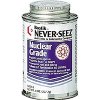it occurred to me that some of the discussion around this contentious topic could benefit from illustration. i.e. if we could see and have a common experience, we may get closer to understanding each other.
So as I just put my 11th 260AI barrel on last night, and took it out today to shoot it for the first time, I thought I would take a close up picture of each patch as I do my version of 'break in'.
my process is simple:
shoot a round, run a patch SOAKED in shooters' choice, wait 10 min, then run patches through til they come out mostly clean and dry.
repeat this until the 2nd patch shows no copper fouling
In this case, you can see a moderate amount of copper on the first round, a lot less on the 2nd round, and almost none by the 3rd round. So, the process involved a total of 3 rounds. On some barrels, this process has taken as many as 6 or 7 rounds. On some, I had no blue on the 2nd round. 3 is pretty average in my experience. So that's a pretty big contrast to the crazy 100+ round procedures some have described.
anyway, this is what it looks like when I do this:
ROUND 1

Note as I push the first patch through, it is soaked in copper solvent. So it picks up a lot of carbon, but the solvent hasn't had time to start dissolving the copper, so you don't see any blue yet.

10 minutes later, the solvent has done its work and the results are obvious. I say this is a moderate amount because I've seen some with a lot more and some with a lot less.


2 more patches and the solvent has been wiped out of the barrel, taking with it most of the carbon and copper.
ROUND 2

round 2 fired, and another solvent soaked patch pushed through the bore.

10 minutes later, the solvent has again done its work, but we see much, much less copper this time. We know the solvent works, so the inevitable conclusion is the second round simply left less copper in the barrel than the first round. The theory is that this is because the tooling marks from the finish reamer in the throat got smoothed out a bit by the first round, and thus scraped less copper off the jacket.


two patches later and the solvent is again wiped out of the bore and patches are pretty much clean. (I don't keep running patches until the carbon fouling stops because I'm eventually going to want my barrel to remain at a stable level of much more carbon fouled than this. I just want to make sure I get the wet solvent out so the barrel is dry.
So as I just put my 11th 260AI barrel on last night, and took it out today to shoot it for the first time, I thought I would take a close up picture of each patch as I do my version of 'break in'.
my process is simple:
shoot a round, run a patch SOAKED in shooters' choice, wait 10 min, then run patches through til they come out mostly clean and dry.
repeat this until the 2nd patch shows no copper fouling
In this case, you can see a moderate amount of copper on the first round, a lot less on the 2nd round, and almost none by the 3rd round. So, the process involved a total of 3 rounds. On some barrels, this process has taken as many as 6 or 7 rounds. On some, I had no blue on the 2nd round. 3 is pretty average in my experience. So that's a pretty big contrast to the crazy 100+ round procedures some have described.
anyway, this is what it looks like when I do this:
ROUND 1

Note as I push the first patch through, it is soaked in copper solvent. So it picks up a lot of carbon, but the solvent hasn't had time to start dissolving the copper, so you don't see any blue yet.
10 minutes later, the solvent has done its work and the results are obvious. I say this is a moderate amount because I've seen some with a lot more and some with a lot less.

2 more patches and the solvent has been wiped out of the barrel, taking with it most of the carbon and copper.
ROUND 2
round 2 fired, and another solvent soaked patch pushed through the bore.
10 minutes later, the solvent has again done its work, but we see much, much less copper this time. We know the solvent works, so the inevitable conclusion is the second round simply left less copper in the barrel than the first round. The theory is that this is because the tooling marks from the finish reamer in the throat got smoothed out a bit by the first round, and thus scraped less copper off the jacket.
two patches later and the solvent is again wiped out of the bore and patches are pretty much clean. (I don't keep running patches until the carbon fouling stops because I'm eventually going to want my barrel to remain at a stable level of much more carbon fouled than this. I just want to make sure I get the wet solvent out so the barrel is dry.









